The John Brinckerhoff Jackson 2021 - Present Book Prize Winners
The John Brinckerhoff Jackson Book Prize is awarded annually to the authors of recently published books that have made significant contributions to the study and understanding of garden history and landscape studies. The winners are listed in alphabetical order and categorized by year.

MATTHEW GANDY
Natura Urbana: Ecological Constellations in Urban Space
MIT Press, 2022
Postindustrial transitions and changing cultures of nature have produced an unprecedented degree of fascination with urban biodiversity. The “other nature” that flourishes in marginal urban spaces, at one remove from the controlled contours of metropolitan nature, is not the poor relation of rural flora and fauna. Indeed, these islands of biodiversity underline the porosity of the distinction between urban and rural. In Natura Urbana, Matthew Gandy explores urban nature as a multilayered material and symbolic entity, through the lens of urban ecology and the parallel study of diverse cultures of nature at a global scale.
Gandy examines the articulation of alternative, and in some cases counterhegemonic, sources of knowledge about urban nature produced by artists, writers, scientists, as well as curious citizens, including voices seldom heard in environmental discourse. The book is driven by Gandy's fascination with spontaneous forms of urban nature ranging from postindustrial wastelands brimming with life to the return of such predators as wolves and leopards on the urban fringe. Gandy develops a critical synthesis between different strands of urban ecology and considers whether "urban political ecology," broadly defined, might be imaginatively extended to take fuller account of both the historiography of the ecological sciences, and recent insights derived from feminist, posthuman, and postcolonial thought.
Matthew Gandy is Professor of Geography at the University of Cambridge and the author of Concrete and Clay and The Fabric of Space, both published by the MIT Press.
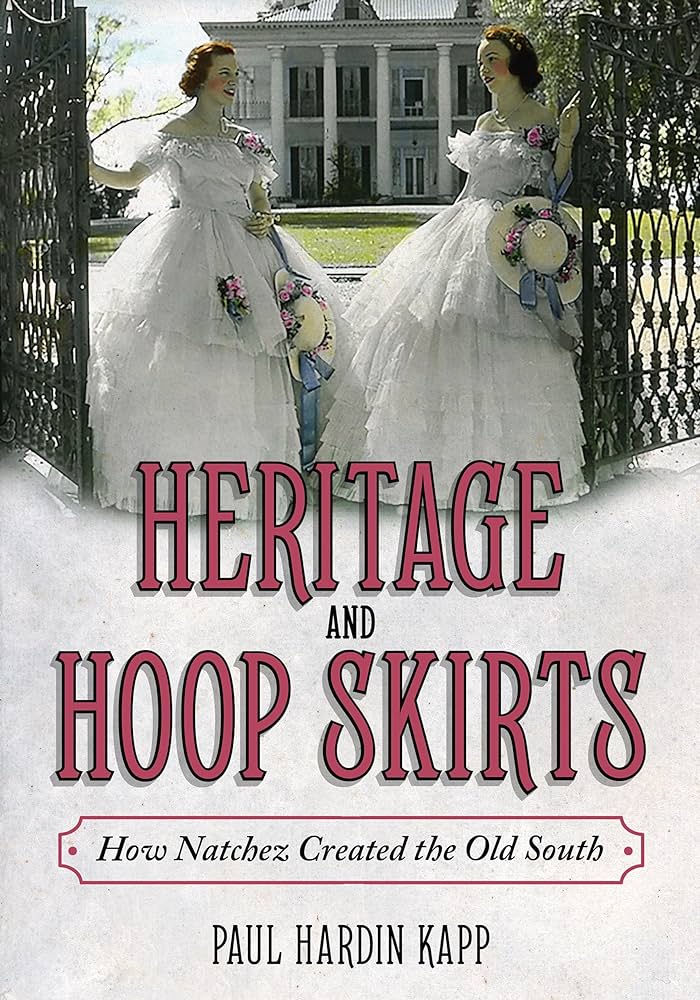
PAUL HARDIN KAPP
Heritage and Hoop Skirts: How Natchez Created the Old South
University Press of Mississippi, 2022
For over eighty years, tourists have flocked to Natchez, Mississippi, seeking the “Old South,” but what they encounter is invention: a pageant and rewrite of history first concocted during the Great Depression. In Heritage and Hoop Skirts: How Natchez Created the Old South, author Paul Hardin Kapp reveals how the women of the Natchez Garden Club saved their city, created one of the first cultural tourism economies in the United States, changed the Mississippi landscape through historic preservation, and fashioned elements of the Lost Cause into an industry.
Beginning with the first Natchez Spring Pilgrimage of Antebellum Homes in 1932, such women as Katherine Grafton Miller, Roane Fleming Byrnes, and Edith Wyatt Moore challenged the notion that smokestack industries were key to Natchez’s prosperity. These women developed a narrative of graceful living and aristocratic gentlepeople centered on grand but decaying mansions. In crafting this pageantry, they created a tourism magnet based on the antebellum architecture of Natchez. Through their determination and political guile, they enlisted New Deal programs, such as the WPA Writers’ Project and the Historic American Buildings Survey, to promote their version of the city.
Their work did save numerous historic buildings and employed both white and African American workers during the Depression. Still, the transformation of Natchez into a tourist draw came at a racial cost and further marginalized African American Natchezians. By attending to the history of preservation in Natchez, Kapp draws on a rich archive of images, architectural documents, and popular culture to explore how meaning is assigned to place and how meaning evolves over time. In showing how and why the Natchez buildings of the “Old South” were first preserved, commercialized, and transformed into a brand, this volume makes a much-needed contribution to ongoing debates over the meaning attached to cultural patrimony.
Paul Hardin Kapp is a professional and academic historic preservationist. He is associate professor of architecture at the School of Architecture and associate director of the Collaborative for Cultural Heritage and Policy, University of Illinois at Urbana-Champaign. He is author of The Architecture of William Nichols: Building the Antebellum South in North Carolina, Alabama, and Mississippi, published by University Press of Mississippi, and coeditor of SynergiCity: Reinventing the Postindustrial City. He is a National Endowment for the Humanities Fellow, a Senior Fulbright Scholar, a James Marston Fitch Mid-career Fellow, and a Franklin Fellow, US Department of State.

LAURA J MARTIN
Wild by Design: The Rise of Ecological Restoration
Harvard University Press, 2022
Environmental restoration is a global pursuit and a major political concern. Governments, nonprofits, private corporations, and other institutions spend billions of dollars each year to remove invasive species, build wetlands, and reintroduce species driven from their habitats. But restoration has not always been so intensively practiced. It began as the pastime of a few wildflower enthusiasts and the first practitioners of the new scientific discipline of ecology.
Restoration has been a touchstone of US environmentalism since the beginning of the twentieth century. Diverging from popular ideas about preservation, which romanticized nature as an Eden to be left untouched by human hands, and conservation, the managed use of natural resources, restoration emerged as a “third way.” Restorationists grappled with the deepest puzzles of human care for life on earth: How to intervene in nature for nature’s own sake? What are the natural baselines that humans should aim to restore? Is it possible to design nature without destroying wildness? Laura J. Martin shows how, over time, amateur and professional ecologists, interest groups, and government agencies coalesced around a mode of environmental management that sought to respect the world-making, and even the decision-making, of other species. At the same time, restoration science reshaped material environments in ways that powerfully influenced what we understand the wild to be.
In Wild by Design, restoration’s past provides vital knowledge for climate change policy. But Martin also offers something more—a meditation on what it means to be wild and a call for ecological restoration that is socially just.
Laura J. Martin is Assistant Professor of Environmental Studies at Williams College. She is a past fellow of the American Council of Learned Societies, the Stanford Humanities Center, and the Harvard University Center for the Environment. She has written for Scientific American, Slate, Environmental History, Environmental Humanities, Trends in Ecology and Evolution, and other publications.

SARA CEDAR MILLER
Before Central Park
Columbia University Press, 2022
With more than eight hundred sprawling green acres in the middle of one of the world’s densest cities, Central Park is an urban masterpiece. Designed in the middle of the nineteenth century by the landscape architects Frederick Law Olmsted and Calvert Vaux, it is a model for city parks worldwide. But before it became Central Park, the land was the site of farms, businesses, churches, wars, and burial grounds—and home to many different kinds of New Yorkers.
This book is the authoritative account of the place that would become Central Park. From the first Dutch family to settle on the land through the political crusade to create America’s first major urban park, Sara Cedar Miller chronicles two and a half centuries of history. She tells the stories of Indigenous hunters, enslaved people and enslavers, American patriots and British loyalists, the Black landowners of Seneca Village, Irish pig farmers, tavern owners, Catholic sisters, Jewish protesters, and more. Miller unveils a British fortification and camp during the Revolutionary War, a suburban retreat from the yellow fever epidemics at the turn of the nineteenth century, and the properties that a group of free Black Americans used to secure their right to vote. Tales of political chicanery, real estate speculation, cons, and scams stand alongside democratic idealism, the striving of immigrants, and powerfully human lives. Before Central Park shows how much of the history of early America is still etched upon the landscapes of Central Park today.
Sara Cedar Miller is the historian emerita of the Central Park Conservancy, which she first joined as a photographer in 1984. Her books include Central Park: An American Masterpiece (2003), Strawberry Fields: Central Park’s Memorial to John Lennon (2011), and Seeing Central Park: The Official Guide (updated and expanded edition, 2020).
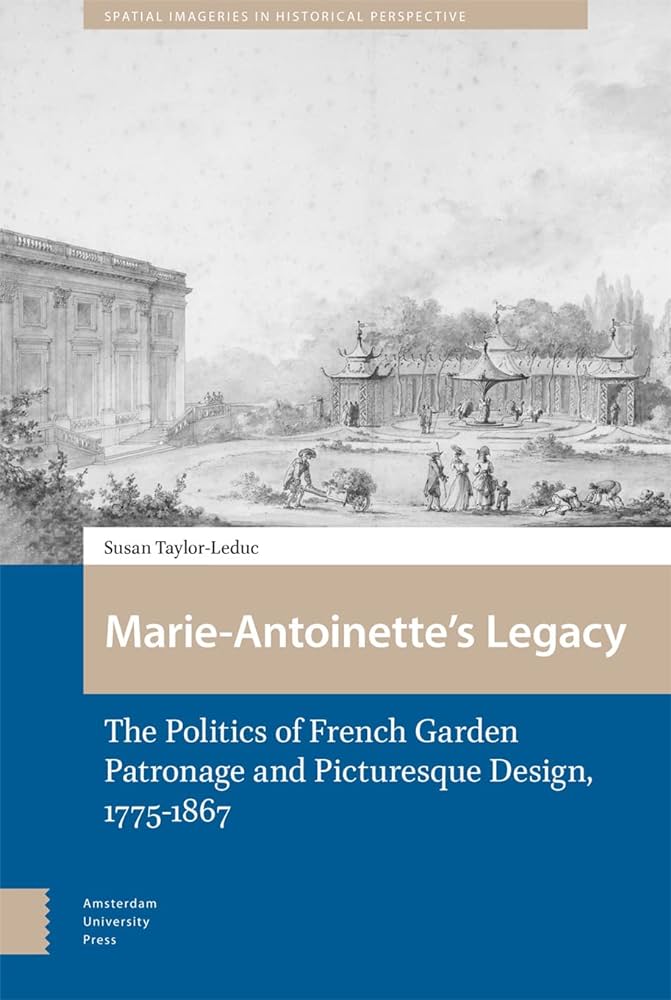
SUSAN TAYLOR-LEDUC
Marie-Antoinette’s Legacy: The Politics of French Garden Patronage and Picturesque Design, 1775-1867
Amsterdam University Press, 2022
Challenging the established historiography that frames the French picturesque garden movement as an international style, this book contends that the French picturesque gardens from 1775 until 1867 functioned as liminal zones at the epicenter of court patronage systems. Four French consorts—queen Marie-Antoinette and empresses Joséphine Bonaparte, Marie-Louise and Eugénie—constructed their gardens betwixt and between court ritual and personal agency, where they transgressed sociopolitical boundaries in order to perform gender and identity politics. Each patron endorsed embodied strolling, promoting an awareness of the sentient body in artfully contrived sensoria at the Petit Trianon and Malmaison, transforming these places into spaces of shared affectivity. The gardens became living legacies, where female agency, excluded from the garden history canon, created a forum for spatial politics. Beyond the garden gates, the spatial experience of the picturesque influenced the development of cultural fields dedicated to performances of subjectivity, including landscape design, cultural geography and the origination of landscape aesthetics in France.
Susan Taylor-Leduc earned both her masters and doctoral degrees from the University of Pennsylvania. Since 1992, she has worked as a teacher, curator and university administrator in Paris. She is currently affiliated with the Centre de Recherche du Château de Versailles.

MATTHIEU DEJEAN AND PERRINE GALAND-WILLEMEN
Chanteloup: The Renaissance Garden of the Villeroys
Droz Publishing, 2022
The garden of the Chanteloup castle (Saint-Germain-lès-Arpajon), owned by the Villeroy-Neufville family, was one of the wonders of the French Renaissance, which could compete with the great Italian gardens of the time. Perrine Galand-Willemen and Matthieu Dejean revive this exceptional artistic creation in its historical and intellectual context. The authors have studied several travel guides and a long Latin poem entitled Cantilupum (Paris, 1587; 1588), which describes the meanders of the garden. Cantilupum was written by Madeleine de L'Aubespine-Villeroy (1546-1596), wife of Secretary of State Nicolas IV de Neufville-Villeroy, lady of honour of Catherine de' Medici, woman of letters whom Ronsard considered his “spiritual daughter”. The garden of Chanteloup housed an extraordinary set of topiaries (carved shrubs), automata, statues, models and fountains, which recreated Roman civilization and offered an initiatory, stoic-Christian course to the walker.
Matthieu Dejean is an independent scholar who studies Renaissance Gardens, Fountains and Nymphaea, and Renaissance Art.
Perrine Galand-Willemen is a French Latinist whose work is focused on the influence and pedagogy of Latin poetics across Europe.

SARAH JENSEN CARR
The Topography of Wellness: How Health and Disease Shaped the American Landscape
UVA Press, 2021
The COVID-19 pandemic has reignited discussions of how architects, landscape designers, and urban planners can shape the environment in response to disease. This challenge is both a timely topic and one with an illuminating history. In The Topography of Wellness, Sara Jensen Carr offers a chronological narrative of how six epidemics transformed the American urban landscape, reflecting changing views of the power of design, pathology of disease, and the epidemiology of the environment. From the infectious diseases of cholera and tuberculosis, to so-called social diseases of idleness and crime, to the more complicated origins of today’s chronic diseases, each illness and its associated combat strategies has left its mark on our surroundings. While each solution succeeded in eliminating the disease on some level, sweeping environmental changes often came with significant social and physical consequences. Even more unexpectedly, some adaptations inadvertently incubated future epidemics. From the Industrial Revolution to present day, this book illuminates the constant evolution of our relationship to wellness and the environment by documenting the shifting grounds of illness and the urban landscape.
Preparation of this volume has been supported by Furthermore: a program of the J. M. Kaplan Fund. Sara Jensen Carr is Assistant Professor of Architecture, Urbanism, and Landscape at Northeastern University.

ANETTE FREYTAG
The Landscapes of Dieter Kienast
GTA Press/ETH Zurich, 2021
Dieter Kienast (1945–1998) is a key figure in European landscape architecture. Amidst a striking change in societal understandings of nature, he sought a synthesis between design and ecology in the 1970s. He designed spaces to make the dissolving opposition between city and countryside legible and to enable aesthetic experience to help cope with increasingly complex everyday life. As a designer, planner, researcher and university lecturer, Kienast introduced new challenges into the discussion of those fields. Critique of urban planning, processes of participation and the significance of spontaneous urban vegetation played just as much a role in these discussions as did art, literature, architecture and the popularity of postmodernism.
Anette Freytag’s award-winning book, which offers the first and comprehensive critical examination of Dieter Kienast, is now available to an international audience in this English edition. It not only vividly deconstructs how design, theory and representation are interwoven in Kienast’s work, but also sheds light on a specific period of landscape architecture.
Anette Freytag is an award-winning scholar, educator and critic and a Professor of the History and Theory of Landscape Architecture at Rutgers University.

CLARE HICKMAN
The Doctor’s Garden: Medicine, Science, and Horticulture in Britain
Yale University Press, 2021
As Britain grew into an ever-expanding empire during the late eighteenth and early nineteenth centuries, new and exotic botanical specimens began to arrive within the nation’s public and private spaces. Gardens became sites not just of leisure, sport, and aesthetic enjoyment, but also of scientific inquiry and knowledge dissemination. Medical practitioners used their botanical training to capitalize on the growing fashion for botanical collecting and agricultural experimentation in institutional, semipublic, and private gardens across Britain. This book highlights the role of these medical practitioners in the changing use of gardens in the late Georgian period, marked by a fluidity among the ideas of farm, laboratory, museum, and garden. Placing these activities within a wider framework of fashionable, scientific, and economic interests of the time, historian Clare Hickman argues that gardens shifted from predominately static places of enjoyment to key gathering places for improvement, knowledge sharing, and scientific exploration.
Clare Hickman is a senior lecturer in history at Newcastle University. She lives in Whitley Bay, United Kingdom.

VALENCIA LIBBY
The Northwest Gardens of Lord & Schryver
Oregon State University Press, 2021
Lord & Schryver, the first landscape architecture firm founded and operated by women in the Pacific Northwest, designed more than two hundred gardens in Oregon and Washington, including residential, civic, and institutional landscapes. Elizabeth Lord and Edith Schryver met as young women and in 1929 established their highly successful firm in Salem; their work is acknowledged as one of the milestones in the history of garden design in the Northwest and beyond. Theirs is the only Oregon firm recognized in Pioneers of Landscape Architecture, compiled by the National Park Service. The Cultural Landscape Foundation describes them as “consummate professionals in the broadest sense, as they worked to raise the profile of landscape architects by involving an audience beyond their clients. Their work represented a transition from a formal symmetrical style of garden design to one which responded in a distinctive way to the unique features of Northwest climate, soil, topography, and plant material.”
Gaiety Hollow, their purpose-built Salem home, garden, and studio, is now owned by the Lord & Schryver Conservancy and is open to the public. The conservancy has lovingly restored the gardens at Gaiety Hollow according to Lord & Schryver’s original plans. They have also restored and now maintain the gardens at Deepwood, a former residence that is now a public park.
Valencia Libby gardens and lectures in Maine. She has researched and taught extensively on women’s contributions to landscape design and horticulture. Libby was an associate professor of landscape architecture and horticulture at Temple University. In 2004 she served as the Fulbright Distinguished Chair in Landscape History in Portugal. She has authored numerous articles on landscape preservation and women’s history.

DAVID MONTEYNE
For the Temporary Accommodation of Settlers: Architecture and Immigrant Reception in Canada, 1870-1930
McGill-Queen’s University Press 2021
For immigrants making the transoceanic journey from Europe or Asia to North America, the experience of a new country began when they disembarked. In Canada the federal government built a network of buildings that provided newcomers with shelter, services, and state support. "Immigration sheds" such as Pier 21 in Halifax - where ocean liners would dock and global migrants arrived and were processed - had many counterparts across the country: new arrivals were accommodated or incarcerated at reception halls, quarantine stations, and immigrant detention hospitals.
For the Temporary Accommodation of Settlers reconstructs the experiences of people in these spaces - both immigrants and government agents - to pose a question at the heart of architectural thinking: how is meaning produced in the built environments that we encounter? David Monteyne interprets official governmental intentions and policy goals embodied by the architecture of immigration but foregrounds the unofficial, informal practices of people who negotiated these spaces to satisfy basic needs, ensure the safety of their families, learn about land and job opportunities, and ultimately arrive at their destinations. The extent of this Canadian network, which peaked in the early twentieth century at over sixty different sites, and the range of building types that comprised it are unique among immigrant-receiving nations in this period.
In our era of pandemic quarantine and migrant detention facilities, For the Temporary Accommodation of Settlers offers new ways of seeing and thinking about the historical processes of immigration, challenging readers to consider government architecture and the experience of migrants across global networks.
David Monteyne is associate professor in the School of Architecture, Planning and Landscape at the University of Calgary.

REBECCA A. SENF
Making a Photographer: The Early Work of Ansel Adams
Yale University Press, 2020
One of the most influential photographers of his generation, Ansel Adams (1902–1984) is famous for his dramatic photographs of the American West. Although many of Adams’s images are now iconic, his early work has remained largely unknown. In this first monograph dedicated to the beginnings of Adams’s career, Rebecca A. Senf argues that these early photographs are crucial to understanding Adams’s artistic development and offer new insights into many aspects of the artist’s mature oeuvre.
Drawing on copious archival research, Senf traces the first three decades of Adams’s photographic practice—beginning with an amateur album made during his childhood and culminating with his Guggenheim-supported National Parks photography of the 1940s. Highlighting the artist’s persistence in forging a career path and his remarkable ability to learn from experience as he sharpened his image-making skills, this beautifully illustrated volume also looks at the significance of the artist’s environmentalism, including his involvement with the Sierra Club.
Published in association with the Center for Creative Photography at the University of Arizona. Rebecca A. Senf is chief curator at the Center for Creative Photography, University of Arizona.

AMITA SINHA
Cultural Landscapes of India: Imagined, Enacted, and Reclaimed
University of Pittsburgh Press, 2020
Most people view cultural heritage sites as static places, frozen in time. In Cultural Landscapes in India, Amita Sinha subverts the idea of heritage as static and examines the ways that landscapes influence culture and that culture influences landscapes. The book centers around imagining, enacting, and reclaiming landscapes as subjects and settings of living cultural heritage. Drawing on case studies from different regions of India, Sinha offers new interpretations of links between land and culture using different ways of seeing—transcendental, romantic, and utilitarian. The idea of cultural landscape can be seen in ancient practices such as circumambulation and immersion in bodies of water that sustain engagement with natural elements. Pilgrim towns, medieval forts, religious sites, and contemporary memorial parks are sites of memory where myth and history converge. Engaging with these spaces allows us to reconstruct collective memory and reclaim not only historic landscapes, but ways of seeing, making, and remembering. In Cultural Landscapes in India makes the case for reclaiming iconic landscapes and rethinking conventional approaches to conservation that take into consideration performative landscape as heritage.
Amita Sinha taught in the Department of Landscape Architecture at the University of Illinois at Urbana Champaign from 1989-2018 and was a visiting professor in the Department of Architecture and Regional Planning, IIT Kharagpur in India. She is the author of Landscapes in India: Forms and Meanings, editor of Landscape Perception, and co-editor of Cultural Landscapes of South Asia: Studies in Heritage Conservation and Management.
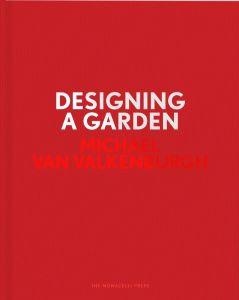
MICHAEL VAN VALKENBURGH
Designing a Garden: Monk's Garden at the Isabella Stewart Gardner Museum
The Monacelli Press, 2019
In Designing a Garden, Van Valkenburgh presents the design of the Monk's Garden at the Isabella Stewart Gardner Museum, an intimate, walled garden that Laurie Olin has described as "a masterpiece, and not a minor one."
The book documents the evolution of the garden's design, which is based on the concept of meandering paths through a dreamlike woodland to create a contemplative space. Sketches and models show how the idea was worked out, and lush photographs reveal the completed garden through the seasons.
Van Valkenburgh's text explores the origins of his love of landscape and plants in his family farm in Upstate New York and how this has influenced his intuitions as a designer. He shares the full background story of the Monk's Garden, focusing on the experimental nature of design work as well as the challenges and satisfactions of the small scale and the historic and cultural context.
Designing a Garden provides a unique first-person account of the design process from the most prominent landscape architects in the country.
Michael Van Valkenburgh is the founder of Michael Van Valkenburgh Associates (MVVA) and formerly the Charles Eliot Professor in Practice of Landscape Architecture at the Graduate School of Design at Harvard University. Based in New York and Cambridge, Massachusetts, his firm is widely acknowledged as a leader in the discipline of landscape architecture. MVVA's design for Brooklyn Bridge Park earned the firm the Municipal Art Society's 2010 Brendan Gill Prize, given each year to the creator of a work of art that best captures the spirit and energy of New York City. Other notable projects include Teardrop Park in New York, waterfront parks in Toronto, Dallas, Tulsa, and Detroit, new gardens at the Menil Collection in Houston, and the landscape surrounding the Barack Obama Presidential Center in Chicago's Jackson Park.

STEPHEN H. WHITEMAN
Where Dragon Veins Meet: The Kangxi Emperor and His Estate at Rehe
University of Washington Press, 2020
In 1702, the second emperor of the Qing dynasty ordered construction of a new summer palace in Rehe (now Chengde, Hebei) to support his annual tours north among the court’s Inner Mongolian allies. The Mountain Estate to Escape the Heat (Bishu Shanzhuang) was strategically located at the node of mountain “veins” through which the Qing empire’s geomantic energy was said to flow. At this site, from late spring through early autumn, the Kangxi emperor presided over rituals of intimacy and exchange that celebrated his rule: garden tours, banquets, entertainments, and gift giving
Stephen Whiteman draws on resources and methods from art and architectural history, garden and landscape history, early modern global history, and historical geography to reconstruct the Mountain Estate as it evolved under Kangxi, illustrating the importance of landscape as a medium for ideological expression during the early Qing and in the early modern world more broadly. Examination of paintings, prints, historical maps, newly created maps informed by GIS-based research, and personal accounts reveals the significance of geographic space and its representation in the negotiation of Qing imperial ideology. The first monograph in any language to focus solely on the art and architecture of the Kangxi court, Where Dragon Veins Meet illuminates the court’s production and deployment of landscape as a reflection of contemporary concerns and offers new insight into the sources and forms of Qing power through material expressions.
Stephen H. Whiteman is senior lecturer in the art and architecture of China at the Courtauld Institute of Art, University of London.
![]()
JANE WOLFF
Bay Lexicon
McGill-University Press, 2021
As human populations inhabiting cities have grown dramatically, we have lost the ability to understand and even to see the natural world around us. We lack the vocabulary to describe our surroundings, and this lack of understanding limits our ability as citizens to contribute to political decisions about the landscape of cities, especially at the edges where land meets water.
Bay Lexicon, a field guide to San Francisco's shoreline, is a case study in establishing a working language for hybrid landscapes. Centred on a walk along the edge of the iconic San Francisco Bay, it documents, deciphers, and classifies the places and phenomena a person encounters - and the forces, histories, and interactions that underlie what is visible. In a unique synthesis of text and drawing, Jane Wolff applies analytical and representational tools based in design and documentary work to findings from the fields of geography, environmental and cultural history, public policy, urban ecology, and landscape studies. As our cities face increasing pressure caused by climate change, we will need to reimagine them in terms that do justice to their complexity. Bay Lexicon‘s methods for building landscape literacy are meant for translation, adaptation, and use far beyond San Francisco Bay.
Through activist scholarship that cuts across disciplinary boundaries and levels of expertise, this book examines how the landscape at the water's edge works, documents its historical evolution, brings its citizens' values to light, and frames conversations about how and why it might change.
Jane Wolff is associate professor at the University of Toronto's Daniels Faculty of Architecture, Landscape, and Design.

Charles E. Beveridge, Lauren Meier, and Irene Mills, editors
Frederick Law Olmsted: Plans and Views of Communities and Private Estates
Johns Hopkins University Press, 2020
Full of original plans and historic photographs, this beautifully illustrated collection is the first comprehensive presentation of Olmsted’s design concepts for communities and private estates. Master landscape architect Frederick Law Olmsted (1822–1903) is renowned for his public parks, but few know the extent of his accomplishment in meeting other needs of society.
Lavishly illustrated with over 500 images, this book presents Olmsted’s design commissions for a wide range of projects. The rich collection of studies, lithographs, paintings, and historical photographs depicts Olmsted’s planning for residential communities, regional and town plans, academic campuses, grounds of public buildings, zoos, arboreta, and cemeteries. Focusing on living spaces designed to promote physical and mental well-being, the book showcases more than seventy of Olmsted’s designs, including the community of Riverside, IL; the Stanford University campus; the U.S. Capitol grounds; the World’s Columbian Exposition of 1893; the National Zoo; and George W. Vanderbilt’s Biltmore estate.
Illuminating Olmsted’s design theory, this volume displays the beautiful plans and reveals the significance of each commission within his entire body of work. Readers concerned with the quality of the environment in which we live and work, as well as architects, landscape architects, urban planners, historians, and preservationists, will find stimulating insights in Plans and Views of Communities and Private Estates.
Charles E. Beveridge is the leading U.S. authority on Olmsted and the series editor of The Papers of Frederick Law Olmsted.
Lauren Meier is a landscape preservationist and a coeditor of The Master List of Design Projects of the Olmsted Firm, 1857–1979.
Irene Mills is a landscape designer. Beveridge, Meier, and Mills are the coeditors of Frederick Law Olmsted: Plans and Views of Public Parks.

Joan Busquets, Dingliang Yang, and Michael Keller
Urban Grids: Handbook on Regular City Design
ORO Editions, 2018
Urban Grids: Handbook for Regular City Design is the result of a five-year design research project undertaken at the Harvard Graduate School of Design. The research that is the foundation for this publication emphasizes the value of open forms for city design, a publication that specifically insists that the grid has the unique capacity to absorb and channel urban transformation flexibly and productively. Urban Grids analyzes cities and urban projects that utilize the grid as the main structural device for allowing rational development and goes further to propose speculative design projects capable of suggesting new urban paradigms drawn from the grid as a design tool.
Joan Busquets, an urban planner and architect, is the first Martin Bucksbaum Professor in Practice of Urban Planning and Design at the Harvard Graduate School of Design.
Dingliang Yang is an Instructor in Urban Planning and Design at the Harvard University Graduate School of Design.
Michael Keller is a landscape and architectural designer and a recent graduate from the Harvard University Graduate School of Design.

Joseph S. Cialdella
Motor City Green: A Century of Landscapes and Environmentalism in Detroit
University of Pittsburgh Press, 2020
Motor City Green is a history of green spaces in metropolitan Detroit from the late nineteenth to the early twenty-first century. The book focuses primarily on the history of gardens and parks in the city of Detroit and its suburbs in southeast Michigan. Cialdella argues that Detroit residents used green space to address problems created by the city’s industrial rise and decline, and racial segregation and economic inequality. As the city’s social landscape became increasingly uncontrollable, Detroiters turned to parks, gardens, yards, and other outdoor spaces to relieve the negative social and environmental consequences of industrial capitalism. Motor City Green looks to the past to demonstrate how today’s urban gardens in Detroit evolved from, but are also distinct from, other urban gardens and green spaces in the city’s past.
Joseph S. Cialdella is the program manager for public scholarship at the University of Michigan.
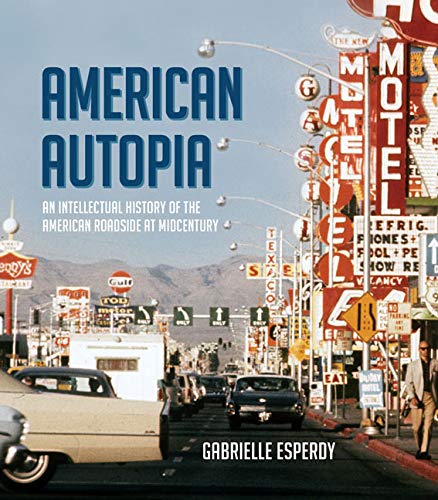
Gabrielle Esperdy
American Autopia: An Intellectual History of the American Roadside at Midcentury
University of Virginia Press, 2019
Early to mid-twentieth-century America was the heyday of a car culture that has been called an “automobile utopia.” In American Autopia, Gabrielle Esperdy examines how the automobile influenced architectural and urban discourse in the United States from the earliest days of the auto industry to the aftermath of the 1970s oil crisis. Paying particular attention to developments after World War II, Esperdy creates a narrative that extends from U.S. Routes 1 and 66 to the Las Vegas Strip to California freeways, with stops at gas stations, diners, main drags, shopping centers, and parking lots along the way.
Drawing on work published in the popular and professional press, and generously illustrated with evocative images, the book shows how figures as diverse as designer Victor Gruen, geographer Jean Gottmann, theorist Denise Scott Brown, critic J.B. Jackson, and historian Reyner Banham constructed “autopia” as a place and an idea. The result is an intellectual history and interpretive roadmap to the United States of the Automobile.
Gabrielle Esperdy is an Associate Professor of Architecture and Design at the New Jersey Institute of Technology and author of Modernizing Main Street: Architecture and Consumer Culture in the New Deal.

Walter Hood and Grace Mitchell Tada, editors
Black Landscapes Matter
University of Virginia Press, 2020
The question “Do black landscapes matter?” cuts deep to the core of American history. From the plantations of slavery to contemporary segregated cities, from freedman villages to northern migrations for freedom, the nation’s landscape bears the detritus of diverse origins. Black landscapes matter because they tell the truth. In this vital new collection, acclaimed landscape designer and public artist Walter Hood assembles a group of notable landscape architecture and planning professionals and scholars to probe how race, memory, and meaning intersect in the American landscape.
Essayists examine a variety of U.S. places – ranging from New Orleans and Charlotte to Milwaukee and Detroit – exposing racism endemic in the built environment and acknowledging the widespread erasure of black geographies and cultural landscapes. Through a combination of case studies, critiques, and calls to action, contributors reveal the deficient, normative portrayals of landscape that affect communities of color and question how public design and preservation efforts can support people in these places. In a culture in which historical omissions and specious narratives routinely provoke disinvestment in minority communities, creative solutions by designers, planners, artists, and residents are necessary to activate them in novel ways. Black people have built and shaped the American landscape in ways that can never be fully known. Black Landscapes Matter is a timely and necessary reminder that without recognizing and reconciling these histories and spaces, America’s past and future cannot be understood.
Walter Hood is a MacArthur Fellow and Professor of Landscape Architecture and Environmental Planning and Urban Design at the University of California, Berkeley, and principal of Hood Design Studio in Oakland, California.
Grace Mitchell Tada is an independent scholar, writer, and journalist.

Helen L. Horowitz
Traces of J. B. Jackson: The Man Who Taught Us to See Everyday America
University of Virginia Press, 2020
J. B. Jackson transformed forever how Americans understand their landscape, a concept he defined as land shaped by human presence. In the first major biography of the greatest pioneer in landscape studies, Helen Horowitz shares with us a man who focused on what he regarded as the essential American landscape, the everyday places of the countryside and city, exploring them as texts that reveal important truths about society and culture, present and past. In Jackson’s words, landscape is “history made visible.”
After a varied life of traveling, writing, sketching, ranch labor, and significant service in army intelligence in World War II, Jackson moved to New Mexico and single-handedly created the magazine Landscape. As it grew under his direction throughout the 1950s and 1960s, Landscape attracted a wide range of contributors. Jackson became a man in demand as a lecturer and, beginning in the late 1960s, he established the field of landscape studies at Berkeley, Harvard, and elsewhere, mentoring many who later became important architects, planners, and scholars. Horowitz brings this singular person to life, revealing how Jackson changed our perception of the landscape and, through friendship as well as his writings, profoundly influenced the lives of many, including her own.
Helen Lefkowitz Horowitz, Sydenham Clark Parsons Professor Emerita of History and American Studies at Smith College, is the editor of Landscape in Sight: J. B. Jackson’s America and author of the Pulitzer Prize-nominated Rereading Sex: Battles over Sexual Knowledge and Suppression in Nineteenth-Century America.

Martin V. Melosi
Fresh Kills: A History of Consuming and Discarding in New York City
Columbia University Press
Fresh Kills – a monumental 2,200-acre site on Staten Island – was once the world’s largest landfill. From 1948 to 2001, it was the main receptacle for New York City’s refuse. After the 9/11 attacks, it reopened briefly to receive human remains and rubble from the destroyed Twin Towers, turning a notorious disposal site into a cemetery. Today, a mammoth reclamation project is transforming the landfill site, constructing an expansive park three times the size of Central Park.
Martin V. Melosi provides a comprehensive chronicle of Fresh Kills that offers new insights into the growth and development of New York City and the relationship among consumption, waste, and disposal. He traces the metamorphoses of the landscape, following it from salt marsh to landfill to cemetery and looks ahead to the future park. By centering the problem of solid-waste disposal, Melosi highlights the unwanted consequences of mass consumption. He presents the Fresh Kills space as an embodiment of massive waste, linking consumption to the continuing presence of its discards. Melosi also uses the landfill as a lens for understanding Staten Island’s history and its relationship with greater New York City. The first book on the history of the iconic landfill, Fresh Kills unites environmental, political, and cultural history to offer a reflection on material culture, consumer practices, and perceptions of value and worthlessness.
Martin V. Melosi is Cullen Professor Emeritus of History and founding director of the Center for Public History at the University of Houston. His many books include The Sanitary City: Urban Infrastructure in America from Colonial Times to the Present (2000) and Atomic Age America (2013).

Mariana Mogilevich
The Invention of Public Space: Designing for Inclusion in Lindsay’s New York
University of Minnesota Press, 2020
As suburbanization, racial conflict, and the consequences of urban renewal threatened New York City with “urban crisis,” the administration of Mayor John V. Lindsay (1966–1973) experimented with a broad array of projects in open spaces to affirm the value of city life. Mariana Mogilevich provides a fascinating history of a watershed moment when designers, government administrators, and residents sought to remake the city in the image of a diverse, free, and democratic society.
New pedestrian malls, residential plazas, playgrounds in vacant lots, and parks on postindustrial waterfronts promised everyday spaces for play, social interaction, and participation in the life of the city. Whereas designers had long created urban spaces for a broad amorphous public, Mogilevich demonstrates how political pressures and the influence of the psychological sciences led them to a new conception of public space that included diverse publics and encouraged individual flourishing. Drawing on extensive archival research, site work, interviews, and the analysis of film and photographs, The Invention of Public Space considers familiar figures, such as William H. Whyte and Jane Jacobs, in a new light and foregrounds the important work of landscape architects Paul Friedberg and Lawrence Halprin and the architects of New York City’s Urban Design Group.
The Invention of Public Space brings together psychology, politics, and design to uncover a critical moment of transformation in our understanding of city life and reveals the emergence of a concept of public space that remains today a powerful, if unrealized, aspiration.
Mariana Mogilevich is a historian of architecture and urbanism and editor-in-chief of Urban Omnibus, the online publication of The Architectural League of New York.
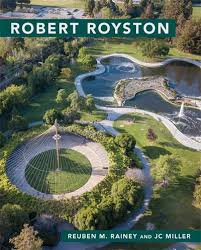
Reuben M. Rainey and JC Miller
Robert Royston
University of Georgia Press, 2020
Over nearly six decades of practice, Robert Royston (1918-2008) shaped the postwar Bay Area landscape with visionary designs for public spaces. Early in his career, Royston conceived of the “landscape matrix,” a system of interconnected parks, plazas, and parkways that he hoped could bring order and amenity to rapidly developing suburbs. The idea would inform his work on more than two thousand projects as diverse as school grounds, new towns, transit corridors, and housing tracts.
As an apprentice of Thomas Church, Royston gained experience with residential gardens that influenced his early designs for public parks. At a time when neighborhood parks were typically limited to playing fields and stock playground equipment, Royston created imaginative facilities for the American family, offering activities for people of all ages.
Royston, Hanamoto & Mayes, founded in 1958, grew to become one of the nation’s most influential corporate firms. With his collaborative approach, Royston designed landscapes that set a high standard of inclusivity and environmental awareness. In addition to the many beloved places he created, his perceptive humanism, which passed down to his students, is Royston’s enduring legacy.
Reuben Rainey, FASLA, professor emeritus at the University of Virginia and co-director of the Center for Design and Health at the University of Virginia, writes on on topics ranging from Renaissance landscape to modern “healing gardens.”
JC Miller is a partner at Vallier Design Associates in Point Richmond, California, and director of the Landscape Architecture Certificate Program at UC Berkeley Extension.

Tom Williamson
Humphry Repton: Landscape Design in an Age of Revolution
University of Chicago Press/Distributed for Reaktion Books Ltd., 2020
Humphry Repton (1752–1818) remains one of England’s most interesting and prolific garden and landscape designers. Renowned for his innovative design proposals and distinctive before-and-after images, captured in his famous “Red Books,” Repton’s astonishing career represents the link between the simple parklands of his predecessor Capability Brown and the more elaborate, structured, and formal landscapes of the Victorian age. This lavishly illustrated book, based on a wealth of new research, reinterprets Repton’s life, working methods, and designs, and examines why they proved so popular in a rapidly changing world.
Tom Williamson is professor of landscape history at the University of East Anglia.
